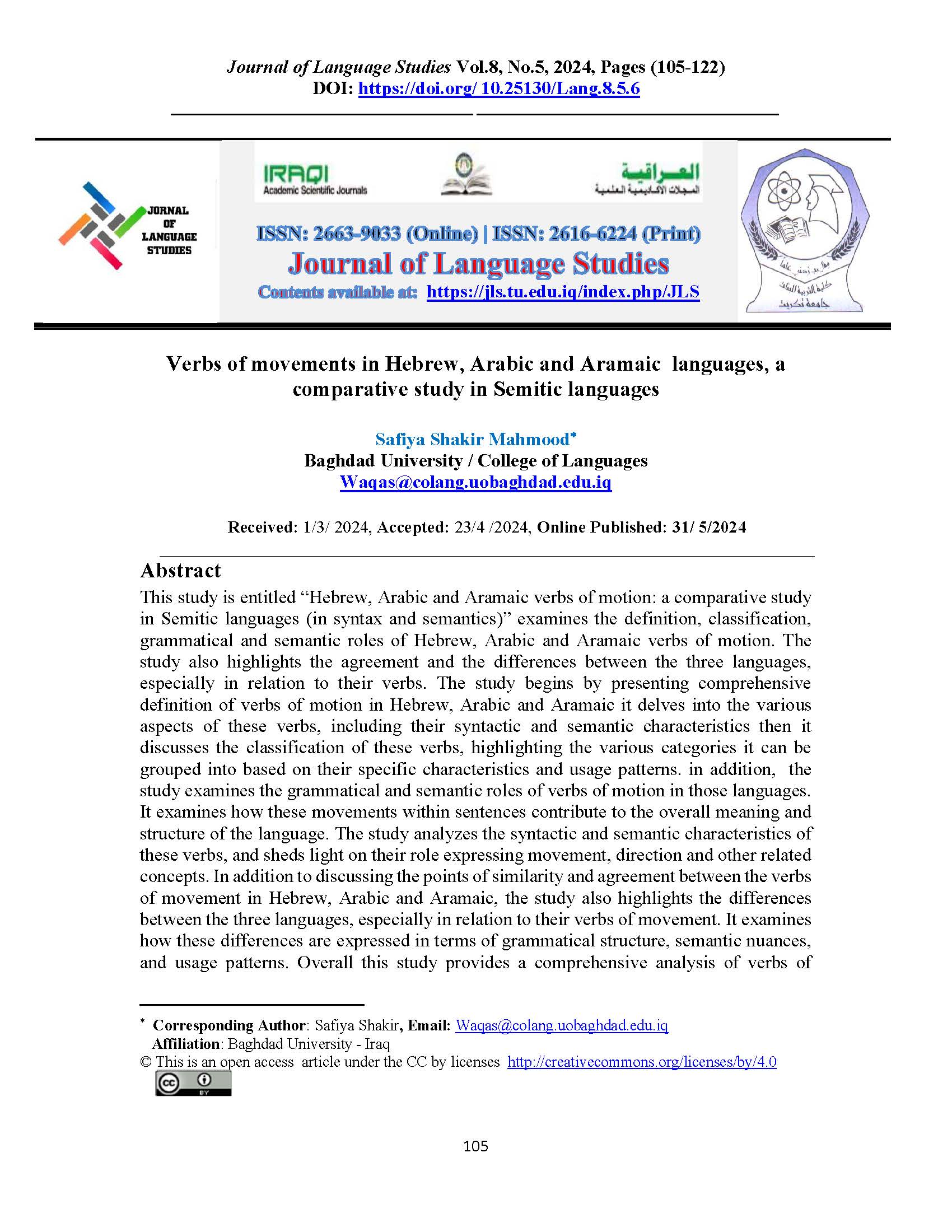Verbs of movements in Hebrew, Arabic and Aramaic languages, a comparative study in Semitic languages
DOI:
https://doi.org/10.25130/Lang.8.5.6Keywords:
verbs of motion, verbs of motion in Semitic language, verbs of location, comparative research in Semitic languages, the semantic role of verbs of motion, the syntactic role of verbs of motionAbstract
This study is entitled “Hebrew, Arabic and Aramaic verbs of motion: a comparative study in Semitic languages (in syntax and semantics)” examines the definition, classification, grammatical and semantic roles of Hebrew, Arabic and Aramaic verbs of motion. The study also highlights the agreement and the differences between the three languages, especially in relation to their verbs. The study begins by presenting comprehensive definition of verbs of motion in Hebrew, Arabic and Aramaic it delves into the various aspects of these verbs, including their syntactic and semantic characteristics then it discusses the classification of these verbs, highlighting the various categories it can be grouped into based on their specific characteristics and usage patterns. in addition, the study examines the grammatical and semantic roles of verbs of motion in those languages. It examines how these movements within sentences contribute to the overall meaning and structure of the language. The study analyzes the syntactic and semantic characteristics of these verbs, and sheds light on their role expressing movement, direction and other related concepts. In addition to discussing the points of similarity and agreement between the verbs of movement in Hebrew, Arabic and Aramaic, the study also highlights the differences between the three languages, especially in relation to their verbs of movement. It examines how these differences are expressed in terms of grammatical structure, semantic nuances, and usage patterns. Overall this study provides a comprehensive analysis of verbs of movement in Hebrew, Arabic and Aramaic. It offers a detailed examination of their definition, classification and grammatical and semantic roles in both language by highlighting the points of agreement and differences in relation to verbs of motion, the study contributes to a deeper understanding of the linguistic characteristics of Hebrew, Arabic and Aramaic.
References
· العرابي، تركي بن عواض بن عبد الله، أفعال الحركة في صحيح البخاري / دراسة دلالية تركيبية ماجستير، مكتبة الملك فهد الوطنية، 2013.
· سماح، رواق، أفعال الحركة في ديوان الأطلس، جامعة محمد خيضر، بسكرة، 2004.
· داود، محمد، محمد، الدلالة والحركة، دراسة لأفعال الحركة في العربية المعاصرة في إطار المناهج الحديثة، دار غريب للطبعة والنشر والتوزيع، 2002.
· معجم مقاييس اللغة - أبو الحسين أحمد بن فارس - دار إحياء التراث العربي / تح: د. محمد عوض مرعب، والأنسة فاطمة محمد أصلان، دار إحياء التراث العربي - 2008.
· בר אבא, אסתר בורוכובסקי, מחקרים בשומרונות בעברית ובארמית, הוצאת מוסד ביאליק, ירושלים, 2004.
· טרומר, פנינה, "מעמדו של מרכיב האופן בהגדרת פעלי התנועה המסוימים", בלשנות עברית חפ"שית", 1988,26 .
· _________ , "המשלימים המוצרכים של פועלי התנועה", בלשנות עברית חפ"שית", 1985,23 .
· _________ , פעלי התנועה בעברית בת ימנו, הוצאת הספרים של מכון מופ''ת, 2002.
· צדקה יצחק, "עוד על פעלי תנועה", בלשנות עברית חפ"שית", 1988,26.
· רוני הנקין, עה בתרגום לעברית: סוגיות בטיפולוגיה וברטוריקה של מבעי תנועה, לשוננו: כתב-עת לחקר הלשון העברית והתחומים הסמוכים לה, כרך סא, ד, אלול התשנ"ח.
· he.wikipedia.org/wiki/משלים_(תחביר), he.wikipedia.org.
· Al-Jallad, A. (2018). Verbs of movement in Arabic. The Oxford Handbook of Arabic Linguistics (pp. 1-18). Oxford University Press.
· Berman, R. A. (1991). The acquisition of Hebrew. In B. MacWhinney (Ed.), The acquisition of language: Psycholinguistic perspectives (pp. 285-364). Routledge.
· Chomsky, N. (1981). Lectures on Government and Binding: The Pisa Lectures. Mouton de Gruyter.
· Glinert, L. (2017). The grammar of Modern Hebrew. Cambridge University Press.
· Huehnergard, John, and Na'ama Pat-El (2018), The Semitic Languages. 2nd edition. Routledge.
· Rendsburg, G. A. (1997). Hebrew verbs of motion and their Semitic cognates. Journal of Semitic Studies, 42(1), 1-18.
· Rosenthal, Franz (1961), A Grammar of Biblical Aramaic, Otto Harrassowitz, Wiesbaden.
· Sichel, I. (2006). Directed motion verbs in Hebrew, Field Manual, Volume 11.
· Stolova, Natalia I, (2015), Cognitive linguistics and lexical change; Motion verbs from Latin to Romance, John Benjamins publishing company.
· Talmy, L. (1985). Lexicalization patterns: Semantic structure in lexical forms. In T. Shopen (Ed.), Language typology and syntactic description (pp. 36-149). Cambridge: Cambridge University Press.

